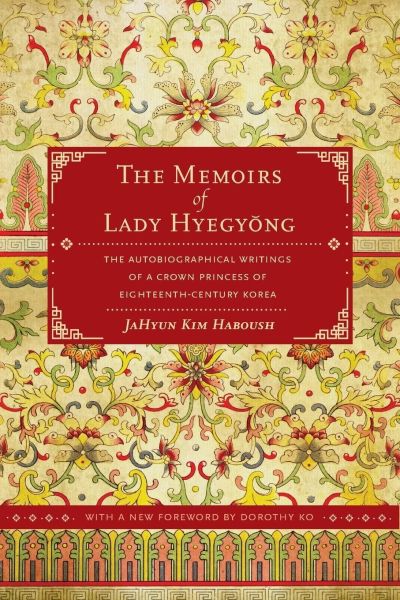Loved And Admired By Everyone
The Memoirs of Lady Hyegyŏng: The Autobiographical Writings of a Crown Princess of Eighteenth-Century Korea
By Lady Hyegyŏng (Translated by JaHyun Kim Haboush)

8 Mar, 2023
0 comments
The Memoirs of Lady Hyegyŏng: The Autobiographical Writings of a Crown Princess of Eighteenth-Century Korea is Lady Hyegyŏng’s account of her life as a Chosŏn crown princess. Translation (and commentary) is by JaHyun Kim Haboush.
The title may mislead. Lady Hyegyŏng lived from 6 August 1735 to 13 January 1816. It would be more accurate to say that she was a princess of 18th and 19th century Chosŏn.
Although as the Memoirs (and The Veritable Records of the Chosŏn Dynasty) make clear, Lady Hyegyŏng lived through an eventful era full of energetic politicking, backstabbing, purges, and remorseless legal prosecution. She is most often remembered for having been married to Crown Prince Sado (13 February 1735-12 July 1762) and for having born King Chŏngjo.
Crown Prince Sado in turn is remembered for his violent and homicidal madness. He died after he was locked in a rice chest by his father, King Yŏngjo of Chosŏn. The peculiar method of removal was selected as it avoided having to condemn the close relatives of the criminal (as was the practice of the time). Hence Lady Hyegyŏng and her son1 survived. Her son became Great Heir Chŏngjo, later Crown Prince Chŏngjo, and still later, King Chŏngjo. Thus the Chosŏn dynasty avoided having to enthrone a madman, but without legally endangering the lineage.
JaHyun Kim Haboush translates Lady Hyegyŏng’s memoirs effectively. The text is preceded by a useful commentary that places the memoirs in their social and historical context. Abundant footnotes and end material also provide useful help. Readers will come away from the text understanding more about the history of Korea and the Chosŏn dynasty.
There’s more to the book than that. Lady Hyegyŏng was a keen-eyed observer of her unfortunate family, of the court, and of the political setting. She survived great calamities with grace and self-possession. She wrote well but carefully; she was well aware of what could be said (and how) and what must not be said (if sometimes hinted).
Her memoir is short but dense … but fascinating. I usually regard autobiographies as a form of non-fiction2, to be read a little at a time. In this case, I was enthralled. I ended up reading the entire work in one go.
The translator, JaHyun Kim Haboush, also wrote a book about the Imjin War. I’m inclined to sample this work as well.
The Memoirs of Lady Hyegyŏng is available here (Amazon US), here (Amazon Canada), here (Amazon UK), here (Barnes & Noble), and here (Book Depository).
I have no idea if The Memoirs of Lady Hyegyŏng is available at Chapters-Indigo.
Foreword
A short commentary by Dorothy Ho on the translator and her work.
Acknowledgements
What it says on the tin.
Introduction
A rather detailed piece, covering the context in which the Memoirs were written, the apparent contradiction between the increasing frequency of women-penned books even as their legal rights were being stripped from them, the purpose and constraints of Chosŏn memoirs, the pressing issue of which of several competing versions of the text to use, whether to present them by internal chronology or the order in which they were written, and other issues.
The introduction alone justifies buying the work.
Principle Persons
Brief descriptions of persons mentioned in the Memoirs.
The Memoirs of Lady Hyegyŏng
The Memoir of 1785
An account of Lady Hyegyŏng’s life as a whole, intended as a defense of actions taken by her and her father, and of the Hongs (her paternal family) in general. The Hongs had a talent for administration and for coming out second during cut-throat political struggles.
I am reminded of the decline of the central family in The Story of the Stone … except that the Hongs were far more likely to exiled or executed.
The Memoir of 1801
Commentary on the corrupt factionalism that led to the persecution of Hongs, in particular of her father, her uncle (who was executed), and her brother (also executed).
The Memoir of 1802
Commentary on her son, King Chŏngjo (27 April 1776 – 18 August 1800), presented with an eye to influencing his successor’s policies.
The Memoir of 1805
Commentary on Crown Prince Sado and the events that led to his confinement in a rice trunk.
1: Crown Prince Sado’s sons by a concubine demonstrated an enormous talent for discovering the limits of official toleration for wacky hijinks. They do not figure into Korean history save as cautionary tales.
2: Leaving aside the issues such as needing to be extremely judicious about how certain facts are presented, lest the author find themselves and their family subject to the hostile scrutiny of the state.
